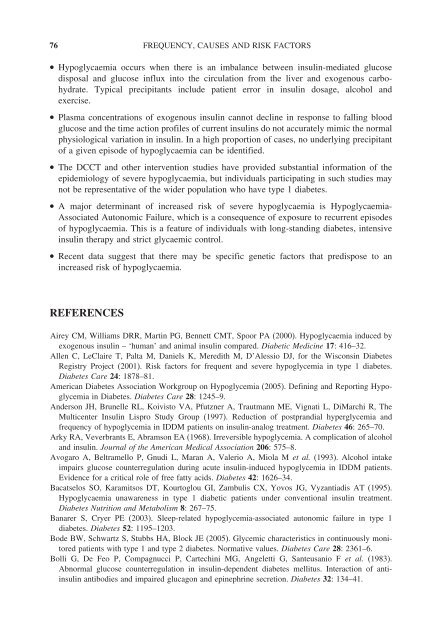Hypoglycaemia in Clinical Diabetes
Hypoglycaemia in Clinical Diabetes
Hypoglycaemia in Clinical Diabetes
- No tags were found...
You also want an ePaper? Increase the reach of your titles
YUMPU automatically turns print PDFs into web optimized ePapers that Google loves.
76 FREQUENCY, CAUSES AND RISK FACTORS• <strong>Hypoglycaemia</strong> occurs when there is an imbalance between <strong>in</strong>sul<strong>in</strong>-mediated glucosedisposal and glucose <strong>in</strong>flux <strong>in</strong>to the circulation from the liver and exogenous carbohydrate.Typical precipitants <strong>in</strong>clude patient error <strong>in</strong> <strong>in</strong>sul<strong>in</strong> dosage, alcohol andexercise.• Plasma concentrations of exogenous <strong>in</strong>sul<strong>in</strong> cannot decl<strong>in</strong>e <strong>in</strong> response to fall<strong>in</strong>g bloodglucose and the time action profiles of current <strong>in</strong>sul<strong>in</strong>s do not accurately mimic the normalphysiological variation <strong>in</strong> <strong>in</strong>sul<strong>in</strong>. In a high proportion of cases, no underly<strong>in</strong>g precipitantof a given episode of hypoglycaemia can be identified.• The DCCT and other <strong>in</strong>tervention studies have provided substantial <strong>in</strong>formation of theepidemiology of severe hypoglycaemia, but <strong>in</strong>dividuals participat<strong>in</strong>g <strong>in</strong> such studies maynot be representative of the wider population who have type 1 diabetes.• A major determ<strong>in</strong>ant of <strong>in</strong>creased risk of severe hypoglycaemia is <strong>Hypoglycaemia</strong>-Associated Autonomic Failure, which is a consequence of exposure to recurrent episodesof hypoglycaemia. This is a feature of <strong>in</strong>dividuals with long-stand<strong>in</strong>g diabetes, <strong>in</strong>tensive<strong>in</strong>sul<strong>in</strong> therapy and strict glycaemic control.• Recent data suggest that there may be specific genetic factors that predispose to an<strong>in</strong>creased risk of hypoglycaemia.REFERENCESAirey CM, Williams DRR, Mart<strong>in</strong> PG, Bennett CMT, Spoor PA (2000). <strong>Hypoglycaemia</strong> <strong>in</strong>duced byexogenous <strong>in</strong>sul<strong>in</strong> – ‘human’ and animal <strong>in</strong>sul<strong>in</strong> compared. Diabetic Medic<strong>in</strong>e 17: 416–32.Allen C, LeClaire T, Palta M, Daniels K, Meredith M, D’Alessio DJ, for the Wiscons<strong>in</strong> <strong>Diabetes</strong>Registry Project (2001). Risk factors for frequent and severe hypoglycemia <strong>in</strong> type 1 diabetes.<strong>Diabetes</strong> Care 24: 1878–81.American <strong>Diabetes</strong> Association Workgroup on Hypoglycemia (2005). Def<strong>in</strong><strong>in</strong>g and Report<strong>in</strong>g Hypoglycemia<strong>in</strong> <strong>Diabetes</strong>. <strong>Diabetes</strong> Care 28: 1245–9.Anderson JH, Brunelle RL, Koivisto VA, Pfutzner A, Trautmann ME, Vignati L, DiMarchi R, TheMulticenter Insul<strong>in</strong> Lispro Study Group (1997). Reduction of postprandial hyperglycemia andfrequency of hypoglycemia <strong>in</strong> IDDM patients on <strong>in</strong>sul<strong>in</strong>-analog treatment. <strong>Diabetes</strong> 46: 265–70.Arky RA, Veverbrants E, Abramson EA (1968). Irreversible hypoglycemia. A complication of alcoholand <strong>in</strong>sul<strong>in</strong>. Journal of the American Medical Association 206: 575–8.Avogaro A, Beltramello P, Gnudi L, Maran A, Valerio A, Miola M et al. (1993). Alcohol <strong>in</strong>takeimpairs glucose counterregulation dur<strong>in</strong>g acute <strong>in</strong>sul<strong>in</strong>-<strong>in</strong>duced hypoglycemia <strong>in</strong> IDDM patients.Evidence for a critical role of free fatty acids. <strong>Diabetes</strong> 42: 1626–34.Bacatselos SO, Karamitsos DT, Kourtoglou GI, Zambulis CX, Yovos JG, Vyzantiadis AT (1995).<strong>Hypoglycaemia</strong> unawareness <strong>in</strong> type 1 diabetic patients under conventional <strong>in</strong>sul<strong>in</strong> treatment.<strong>Diabetes</strong> Nutrition and Metabolism 8: 267–75.Banarer S, Cryer PE (2003). Sleep-related hypoglycemia-associated autonomic failure <strong>in</strong> type 1diabetes. <strong>Diabetes</strong> 52: 1195–1203.Bode BW, Schwartz S, Stubbs HA, Block JE (2005). Glycemic characteristics <strong>in</strong> cont<strong>in</strong>uously monitoredpatients with type 1 and type 2 diabetes. Normative values. <strong>Diabetes</strong> Care 28: 2361–6.Bolli G, De Feo P, Compagnucci P, Cartech<strong>in</strong>i MG, Angeletti G, Santeusanio F et al. (1983).Abnormal glucose counterregulation <strong>in</strong> <strong>in</strong>sul<strong>in</strong>-dependent diabetes mellitus. Interaction of anti<strong>in</strong>sul<strong>in</strong>antibodies and impaired glucagon and ep<strong>in</strong>ephr<strong>in</strong>e secretion. <strong>Diabetes</strong> 32: 134–41.
















